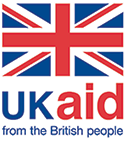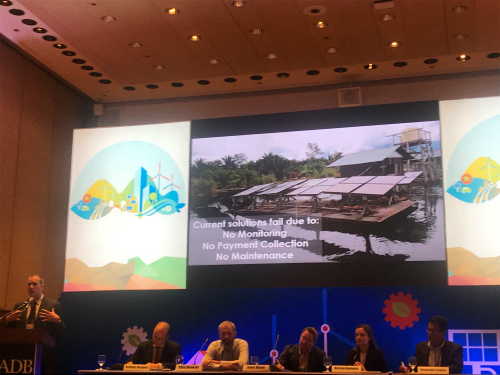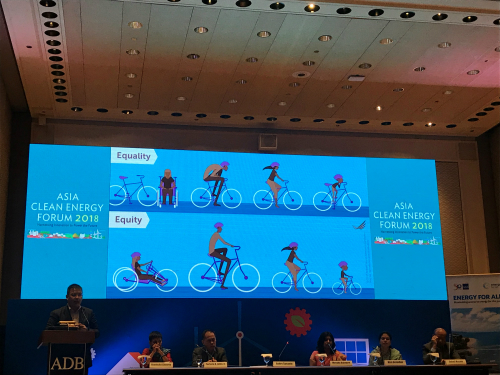On a hot June morning, I make my way through the busy streets of Manila towards the Asian Development Bank headquarters. It is the week of the Asia Clean Energy Forum and the ADB office is buzzing with a diverse mix of project developers, financial institutions, non-profits, entrepreneurs, government and academia shaping the path to a clean energy future for Asia. This edition of the ACEF was focused on how innovation can accelerate energy system development through a week-long series of discussions and workshops on four key thematic areas – energy efficiency, renewable energy, energy access and navigating the future.
Invited to be a panellist at the ‘Access to Finance – SE4ALL in the Asia Pacific’ session, I was excited to share success stories from the GSMA Mobile for Development (M4D) Utilities grantee portfolio with the ACEF community. The M4D Utilities Innovation Fund has to date provided £4.5 million to 29 innovative energy companies across Africa and the Asia-Pacific. My session focused on ways of encouraging finance flows in the decentralised energy space. To put things into perspective, estimates show an annual investment of $45 billion is needed to meet universal electrification SDG goals (SE4ALL Energizing Finance: Scaling And Refining Finance In Countries With Large Energy Access Gaps).
Extending the grid requires significant investment and time while decentralised solutions can offer lower-cost technological alternatives, especially in areas where the cost of extending the grid are particularly high. We need to adopt an integrated approach towards electrification. Leveraging the reach of mobile networks and mobile technology enables key functionalities of off-grid energy solutions, such as payment channels, remote monitoring and control, smart metering and customer communication will be a key enabler.
After a week of intensive workshops and thought-provoking presentations, highlighting key trends in the region and showcasing innovations in clean energy, it is clear that technology will play a crucial role in enabling future energy access in the Asia Pacific region.
Key takeaways from the ACEF 2018
1. Transformative role of technology in accelerating energy access,
- Pay-as-you-go (PAYG) energy models – the PAYG model, often enabled by mobile payments and GSM remote control, has become the dominant means of rolling out off-grid energy systems across the world. In East and West Africa, where mobile money is a fundamental component of these models, PAYG companies raised about $263 million in capital in 2017 – up 19 per cent from 2016 – and served more than 700,000 customers (Renewables 2018 Global Status Report, 2017).
- Blockchain technology and artificial intelligence applications – Blockchain acts as a decentralised public ledger, which enables money transfer between different entities on a network, without the need for a verifying central authority. It is also paving the way for peer-to-peer energy trading, where people can trade renewable energy and be able to get energy back from the grid. SunContract is one such energy-trading platform that utilises blockchain technology to facilitate energy trading. The use of artificial intelligence, data analytics and predictive modelling for energy optimisation, credit scoring, predictive maintenance and predicting customer behaviour is also gaining momentum.
2. Annual investment of $45 billion is needed to meet universal electrification targets – this will require greater investment in decentralised energy solutions
- Of the $40 billion invested in electrification during 2013 and 2014, only one per cent went to decentralised electrification (Renewables 2018 Global Status Report, 2017). Why is this happening? Experts believe that poor investor awareness of the technology and the fact that demonstrating financial sustainability is still a challenge for PAYG solutions, are the key deterrents.
- Innovative financing instruments are needed to facilitate working capital debt – Clean energy companies have easy access to impact capital and early stage equity but often struggle with debt. Securitisation or financing customer receivables of PAYG companies using mobile payments can assure investors that their repayments are secure thus encouraging additional investments in the sector. Where customers are unbanked, mobile money becomes particularly important for assurance of customer payments.
- Catalytic role of grant funding – there is a need for patient grant capital to bear the upfront risk thereby unlocking capital in far bigger scale, particularly for universal energy access goals under SDG7 (SunConnect, 2018: Mixing up finance: Smooth or lumpy results?). Tiered financial instruments such as loan guarantees and concessional finance are also fast emerging.
3. Regional trends/developments
- REN21’s Renewables 2018 Global Status Report indicates that the number of people in Asia without access to electricity decreased from over one billion in 2000 to 0.44 billion in 2016, with significant progress particularly in Bangladesh, China, India and Indonesia. We still have a long way to go in reaching the 0.44 billion people. The good news is that lower costs for renewable energy technologies and off grid innovation should help countries be creative in meeting this challenge.
- Governments are showing an interest in the clean energy space and leading large-scale projects. The Sri Lankan government has played a big role in achieving 97 per cent electrification in the country. A GSMA grant to the mobile operator, Dialog, has helped to launch smart metering with LECO to improve and expand grid services. Indonesia has also seen their government agency deploy over 900 mini-grids across their remote islands. Electric Vine Industries, from our latest cohort of grantees, is partnering with Telkomsel to pilot smart metered micro-grids in Sumba, Indonesia.
- Recognising young clean energy entrepreneurs and innovators – seven New Energy Leaders were awarded for their innovative work in the clean energy sector. Anjal Niraula from Gham Power was amongst this prestigious group of energy leaders. In 2015, the M4D Utilities programme awarded Gham Power a grant to expand the capacity of two micro-grids in Nepal, the details of which are provided here.
It is hard to believe that despite accounting for a third of the world’s GDP and more than half of the global economic growth, the Asia–Pacific region is still home to 440 million people living without electricity. Interestingly, of the total 3.9 billion APAC population, 2.7 billion have a mobile connection, accounting for two thirds of the region’s population (GSMA Intelligence: The Mobile Economy Asia-Pacific 2017). More than half the world’s mobile subscribers live in Asia Pacific – mostly in China and India.
Our ability to ensure energy access for these people, most of whom live in remote areas and islands, will largely depend on use of innovative technologies and business models, starting with the far-reaching presence of mobile networks.
This initiative is currently funded by the UK Department for International Development (DFID), the Scaling Off-Grid Energy Grand Challenge for Development and
supported by the GSMA and its members.





